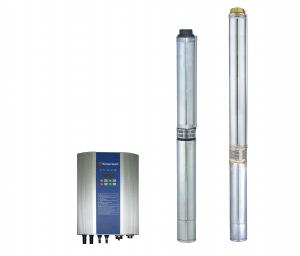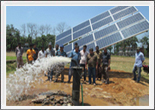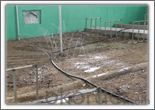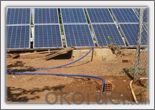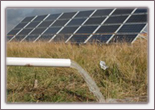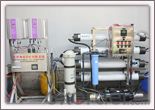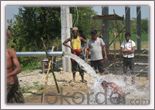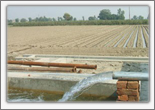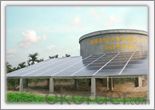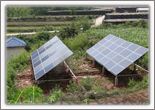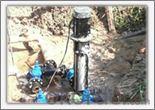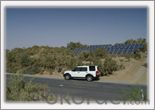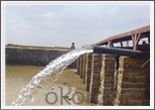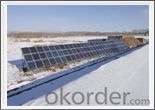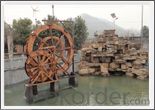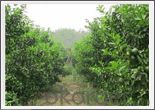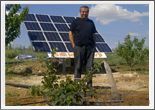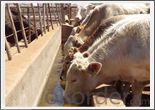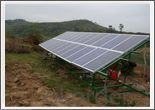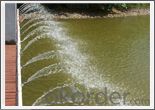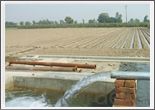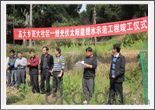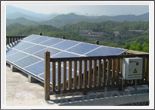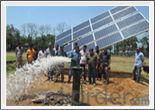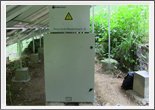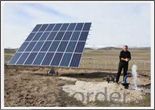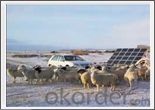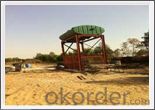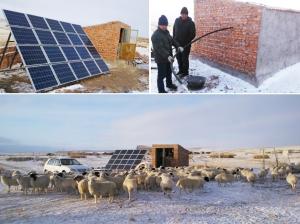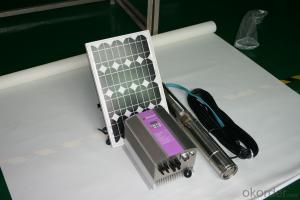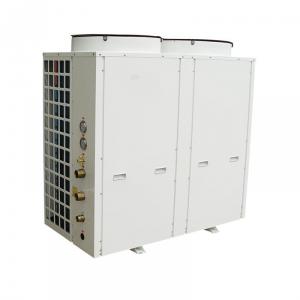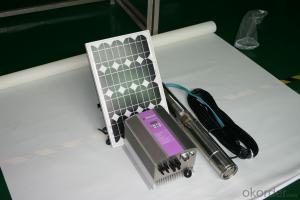Solar Pump Suppliers - Water for Life Solar Pumping Systems
- Loading Port:
- Shekou
- Payment Terms:
- TT OR LC
- Min Order Qty:
- 20 unit
- Supply Capability:
- 800000 unit/month
OKorder Service Pledge
OKorder Financial Service
You Might Also Like
Solar Inverter Introduction:
Solar pumping inverter converts DC current from the solar array into AC current to drive the pump. With the function of MPPT (maximum power point tracking), it regulates the output frequency according to irradiation in real time to achieve the maximum power.
Solar Inverters Features:
1. Adopting the proposed dynamic VI maximum power point tracking (MPPT) control method; Fast response and stable operation; Better than the conventional methods which may lead to the problems including poor tracking performances, unstable or even cause water hammer damaging when the irradiation on the array changes rapidly.
2. The solar pumping inverters system is dispensed with energy storing devices, and stores water instead of electricity. It improves the reliability of the device, at the same time, it lowers the construction and maintenance costs of the system dramatically.
3. Digital control; automatic operation and data acquisition/storage of 8 years, etc; 98% of conversion efficiency, and complete protection.
4. In-line blocks; user friendly; convenient for operating; perfect cooling and shielding.
Solar Pumping Inverter Advantages:
1. To drive pumps equipped with 3-phase induction motors.
2. Optimized SPWM.
3. Various operation modes and MPPT algorithms are available.
4. Adjustable speed range of pump based on the actual situation of the system.
5. Available option of water-level detecting and control circuit.
6. Protection functions: lightning, over/low input voltage, over current and over load protection, etc.
7. Enclosure class: IP52.
8. Ambient temperature:-10~+50˚C.
Specification:
Model | Maximum input dc voltage | Recommended MPP Voltage | Rated Output Current | Output Voltage | Output Frequency | Net Weight | Gross Weight | Package Size | ||
Length | Width | Height | ||||||||
PB5500H | 750 | 500-600 | 13 | 3PH 380V | 0-50 | 7.3 | 9.6 | 425 | 325 | 285 |
PB7500H | 750 | 500-600 | 18 | 3PH 380V | 0-50 | 7.7 | 10 | 425 | 325 | 285 |
PB11KH | 750 | 500-600 | 24 | 3PH 380V | 0-50 | 8.2 | 10.5 | 425 | 325 | 285 |
PB15KH | 750 | 500-600 | 30 | 3PH 380V | 0-50 | 8.4 | 10.7 | 425 | 325 | 285 |
PB18KH | 750 | 500-600 | 39 | 3PH 380V | 0-50 | 8.4 | 10.7 | 425 | 325 | 285 |
PB22KH | 750 | 500-600 | 45 | 3PH 380V | 0-50 | 18 | 21 | 600 | 465 | 350 |
PB30KH | 750 | 500-600 | 60 | 3PH 380V | 0-50 | 18 | 21 | 600 | 465 | 350 |
PB37KH | 750 | 500-600 | 75 | 3PH 380V | 0-50 | 20 | 23 | 600 | 465 | 350 |
PB45KH | 750 | 500-600 | 91 | 3PH 380V | 0-50 | 20 | 23 | 600 | 465 | 350 |
PB55KH | 750 | 500-600 | 112 | 3PH 380V | 0-50 | 20 | 23 | 600 | 465 | 350 |
►Middle East ►NaQu ►GuiLin
►Turkey ►XiNing ►YunNan
►Army stationed island ►Bangladesh ►Pakistan
►HaiNan ►HuBei ►Uganda
►XinJiang ►NingXia ►Afghan
►Zimbabwe ►Inner Mongolia ►Zhejiang
►Guangxi Guilin ►Turkey2 ►Botswana
►Naning ►Uganda ►Shaanxi
►Tsinghua University ►Pakistan ►Yunnan2
►FuJian ►Banqladesh ►YunNan3
►Turkey ►Inner Mongolia ►Senegal
- Q: Are there any limitations to the size of particles a solar pump can handle?
- Indeed, the size of particles that a solar pump can manage is subject to limitations. Generally, solar pumps are engineered to accommodate diminutive particles like sand, silt, or debris that could potentially exist in the water source. Nonetheless, if the particles are excessively sizable or compact, they have the potential to obstruct or harm the pump system. Moreover, larger particles can also impact the pump's efficiency, thus diminishing its performance and output. Consequently, it is crucial to take into account the size and nature of particles present in the water source while selecting a solar pump to guarantee its ability to manage them effectively without any complications.
- Q: How durable are solar pumps?
- Solar pumps are highly durable and designed to withstand various weather conditions, including extreme heat, cold, and humidity. With no moving parts, they are resistant to wear and tear, making them reliable and long-lasting in terms of durability. Additionally, they require minimal maintenance, further contributing to their overall durability.
- Q: Are there any limitations to the temperature range a solar pump can operate in?
- Yes, there are limitations to the temperature range a solar pump can operate in. Extreme cold temperatures can cause freezing of the water inside the pump, leading to damage or malfunction. On the other hand, extremely high temperatures can affect the efficiency and performance of the pump's components, such as the solar panels and motor. Thus, solar pumps typically have specified temperature ranges within which they can effectively operate.
- Q: Can solar pumps be used for water supply in military bases or camps?
- Yes, solar pumps can be effectively used for water supply in military bases or camps. Solar-powered pumps are capable of providing a reliable and sustainable source of water, making them an ideal solution for remote locations where electricity supply may be limited or unreliable. The use of solar pumps not only reduces dependence on fossil fuels but also offers cost savings in the long run. Additionally, their simplicity and ease of installation make them a practical choice for military operations in various terrains.
- Q: Can a solar pump be used for pool heating?
- Yes, a solar pump can be used for pool heating. Solar pumps circulate water through solar panels, where it is heated by the sun's energy and then returned to the pool. This method of pool heating is efficient, environmentally friendly, and can help reduce energy costs.
- Q: Can solar pumps be used in remote locations?
- Yes, solar pumps can be effectively used in remote locations. Since they operate on solar power, they do not require access to electricity grids, making them ideal for areas that are far away from power sources. Solar pumps can provide a sustainable and reliable water supply for various applications such as agriculture, livestock, and domestic use in remote areas.
- Q: Can a solar pump be used for water supply in agricultural greenhouses?
- Yes, a solar pump can be used for water supply in agricultural greenhouses. Solar pumps are increasingly being used in greenhouse farming as they are cost-effective, environmentally friendly, and can provide a reliable source of water for irrigation. By harnessing solar energy, these pumps can efficiently draw water from wells, rivers, or other sources and distribute it to the crops within the greenhouse, ensuring optimal growth and productivity.
- Q: Can a solar pump be used for water supply in remote mountain regions?
- Yes, a solar pump can be used for water supply in remote mountain regions. Solar pumps are a sustainable and efficient solution for remote areas as they utilize solar energy to power the pump and draw water from underground sources. This eliminates the need for electricity or fuel, making it a cost-effective and environmentally-friendly option for water supply in such regions.
- Q: What is the maximum temperature a solar pump can handle?
- The maximum temperature a solar pump can handle can vary depending on the specific model and manufacturer. However, in general, most solar pumps are designed to handle temperatures up to 50-60 degrees Celsius (122-140 degrees Fahrenheit). It is important to refer to the product specifications provided by the manufacturer to determine the exact maximum temperature rating for a particular solar pump model. Additionally, it is advisable to install the pump in a location that minimizes exposure to extreme temperatures and provides adequate ventilation to ensure optimal performance and longevity.
- Q: Can a solar pump be used in areas with high levels of pollution?
- Yes, a solar pump can be used in areas with high levels of pollution. Solar pumps are powered by sunlight, so they do not rely on conventional power sources that contribute to pollution. As long as there is sufficient sunlight to generate electricity, the solar pump can operate efficiently regardless of the pollution levels in the area.
Send your message to us
Solar Pump Suppliers - Water for Life Solar Pumping Systems
- Loading Port:
- Shekou
- Payment Terms:
- TT OR LC
- Min Order Qty:
- 20 unit
- Supply Capability:
- 800000 unit/month
OKorder Service Pledge
OKorder Financial Service
Similar products
Hot products
Hot Searches
Related keywords
